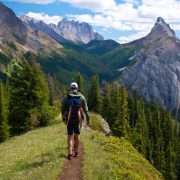
Hiking can be fun and relaxing – especially if you live in a big city, getting out into the countryside for a long day of walking can give you a different perspective and help to combat the stress of urban living. It can also be surprisingly effective exercise: a cardio workout that helps to build stamina and bone density, as well as strengthening your core, and your glutes, quads and hamstrings, among other muscles.
You can run into problems if you don’t prepare properly, or even simply not have the best time. Today we’re looking at how you can prepare for your next hike, so you stand the best chance of having the best time!
Supplies
Don’t leave packing till the last minute: a long hike isn’t a walk in the park, and there are some things you’ll need to buy in advance.
A map of the area you’re hiking can be useful – while your phone is a great navigation aid, it gets less reliable away from built up areas, and learning to read a paper map can make you feel more accomplished and expert, and gives you something to fall back on if you encounter signal or batter problems.
Water is the most important thing you can bring with you, but alone, it’s not the best way to rehydrate. You don’t just lose water when you sweat: you also lose some important chemicals for your body: the salts that are dissolved in your sweat, which are called electrolytes. These are used by your body to balance the fluid levels in your cells, to maintain your mood and ensure nerve impulses can be transmitted around your body to muscles. If you’re going for a long walk in hot conditions, add some rehydration pills or powders to your pack to top up your electrolyte levels and ensure you don’t get into difficulties.
Research
You’ll have a better time if you plan and research your route. This doesn’t mean you don’t allow yourself to be spontaneous and see what’s over the hill or around a bend in the path, but if you check where you’re walking in advance you’ll have a better idea which diversions will be lead to rewarding views, country pubs or sites of interest, and which are mere dead ends.
When you’ve planned your route, tell at least one friend where you’re going and when you expect to be back. Even on well trodden paths, you could get into difficulties and a friend realising you haven’t checked in when you were meant to could be a life saver!
